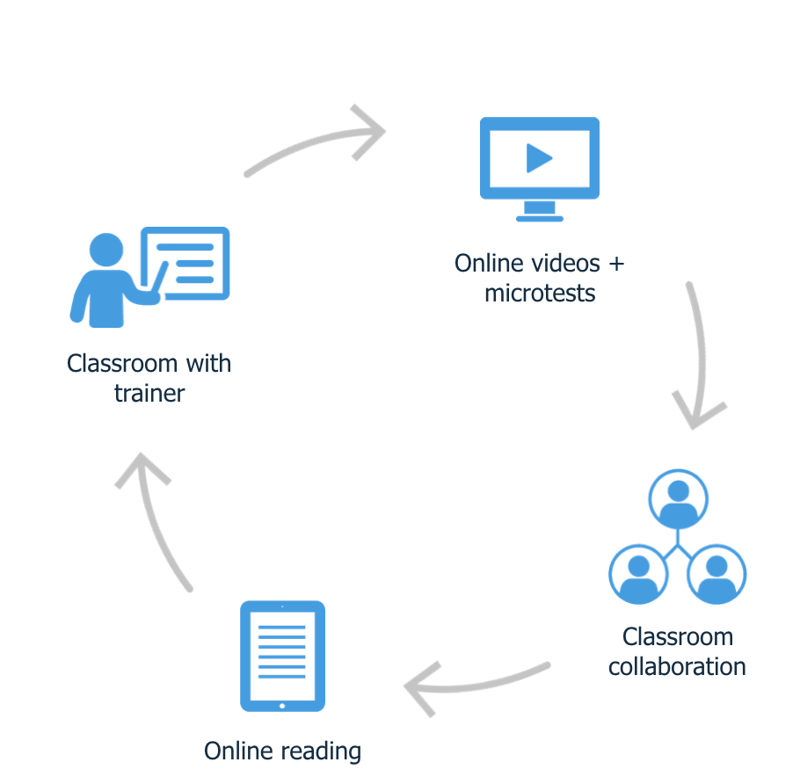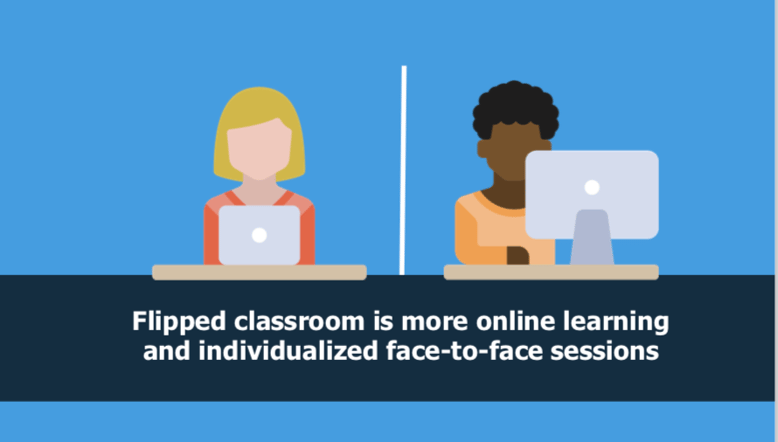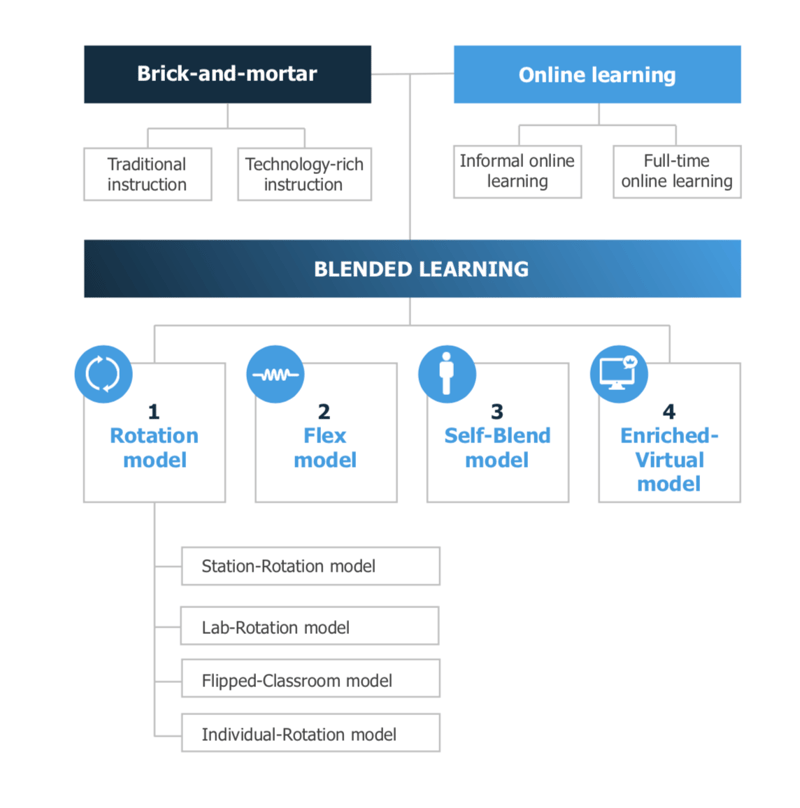Blended learning definition

Blended learning blends the best out of face-to-face classes and e-learning. In blended learning digital tools are not competing against traditional methods of teaching and learning, but rather complementing them, improving the efficiency and flexibility of the learning process.
Blended learning is one of the most effective training and learning methods. Therefore most prestigious consulting and training companies such as Ernst & Young use it. Blended learning is exploited by diverse organizations from local schools to multinational giants such as Oracle or Cisco.
We can confidently say that blended learning is here to stay. We encourage you to read this document to discover the basics of blended learning, interesting cases and advice on how to get started.
Searching this topic, you might also encounter the terms b-learning or hybrid learning, which essentially bear the same meaning.
Blended learning benefits
Blended learning combines all advantages
Blended learning has been demonstrated to be more efficient than face-to-face classrooms or full e-learning. Blended learning also improves the trainee's motivation and engagement when done correctly
Advantages of classroom training
- Interchanging knowledge
- Encourage teamwork
- Efficient personal help
- Understanding emotional climate
Advantages of e-learning
- Flexibility to study when and where you can
- More affordable
- No limitations on the number of attendants
- Materials are always up to date
- Rich, interactive material
Testimonial from a blended learning trainer
As a trainer, one of my greatest challenge has been engaging the brightest students, and still meet the needs of those who need more time and assistance. You always end up teach to the middle. The brightest students get bored, and others fell behind. With blended learning, trainers can really and truly meet the needs of each individual and reach them where they are. This always has been the goal, but until now, the tools simply weren't there.
This is an incredibly exciting time to be a trainer.
-Alex, San Diego High School
Blended learning modes
We are familiar with these four B-learning modes.

Rotation mode blended learning
We talk about rotation b-learning when we organize the activities in different stages. Each stage implicates different tasks. To rotate, you form groups of trainees and then rotate the groups from task to task at a certain time interval.
There are four different sub-models in the rotation blended learning
- Stage rotation. There are different stages, and student groups work on activities in each work stage.
- Computer-aided rotation. Trainees work with electronic devices such as computers, tablets and smartphones. In classrooms, there are no electronic devices that time there are for questions and doubts.
- Flipped classroom. In a Flipped classroom, the traditional usage of classrooms reverts. The goal is more individualized training and enhanced trainer-student relationships. Most of the learning happens online. Classrooms usage is about solving trainee doubts and questions face to face.
- Individual rotation. In this model, the trainee has individual tasks based on individual needs. Information can be all studied online or for example with smartphones. But the tasks are different for each student or trainee.

The best blended learning model for your use depends on your theme, objectives and trainees. There is no one best mode for everyone, you have to get started and with time you will learn what method works for your courses.
Flexible mode blended learning (flex mode)
Online activities in flexible mode form a large part of the training. Trainees or students have the flexibility to move between different forms of b-learning. Each individual may customize their learning to best suit their personal requirements.
Trainees' or students' progress or performance can be easily tested with time to time classroom exams or/and different online tests.
In the menu model, the trainee may select specific subjects to study online. Other, predefined amount of subjects are face-to-face classes. With the menu model, the trainer’s presence guiding and supporting online subjects is crucial.
Enhanced virtual mode blended learning
Enhanced virtual model. In this model scheduled classroom sessions to exist, but they are not obligatory. In this model, the trainer’s virtual presence online is very important, as questions arise. The trainer may use a chat functionality e.g. to answer students' or trainees' questions.

Blended learning case examples
Example 1
National Electrical Association Contractors (NECA), US.
The electrical training ALLIANCE reaches beyond the textbook, incorporating advanced technology in all aspects of training. Blended learning enables students to continue training remotely, bridging the gap between an apprenticeship and learning in the classroom. The electrical training ALLIANCE encourages training centres to embrace new technologies and offers ongoing technical courses to support all facilities using its curriculum. Since instructors and students can connect virtually, training on the go is easier than ever. Blended Learning also enhances the classroom time as Instructors can spend more time with hands-on instruction rather than going over homework.
Example 2
San Diego, United States
A network of schools in San Diego called High Tech High, has established a b-learning system where many classes are divided into two parts, face-to-face learning and digital learning. Their primary and secondary students, in total 5.300 students in 13 public schools use digital tools to complete mathematics and language studies. 2010 the b-learning results were proven, 100% of the b-learning course students were accepted to university and 93% of them passed California High School Exit Exams (against the 80% average).
Example 3
CISCO system
Cisco started using online videos as part of its internal b-learning strategy years ago. Given the excellent results, Cisco is still using b-learning for almost all internal courses.
Example 4
Ernst & Young
Also multinational consultancy gigantic Ernst & Young takes economical and geographical advantage using b-learning courses for internal training. Face-to-face parts are done by using teleconference systems, but a major part of the training is done fully digitally.
Blended learning, getting started
1. Go through the material you already use in your courses, and put available online all the material and content suitable for studying independently. You should also estimate the time each trainee needs to complete the online material, so they can anticipate the required time. Remember to divide your material into courses with clear objectives
So you got started – Congratulations, it's the most difficult part!
2. Include some tests for the online material
- Level testing
- Orientated exams
- Brainstorming tasks
You could for example include a few questions after each module so that the trainee may test his/her own know-how on the topic and also add some questions to discuss in the class. This also helps you to understand the level of your trainees or students are at, and you may better prepare for the face to face studies.
You already are a blended learning practitioner. From here on, it's more perfectioning and taking the most out of it!
Blended learning, best practices
- Maintain the most complex theory parts in the face to face classes if you think there is no benefit in studying them independently. You can also repeat the theory at the beginning of the class to refresh the memory and make sure trainees understand the context or bigger picture. Another possible approach is to focus on the same theory but from a very different angle. This makes it interesting and improves memory.
- Make sure most of the time in face-to-face classes you use it for discussions, questions and exercises. If you had your trainees do some exercises (online or offline), go through them for example. In blended learning, you should not be lecturing in the face to face classes, but rather discuss and collaborate on difficult issues, and applicate the learned information.
- Have a little recap after each session to make sure the information was absorbed. If there are clear deficiencies, return back to that later.
- In your online material, you should include some instructions on the time schedule, progress and the exercises for the next face-to-face session. Also, please try to estimate the time your trainees will need to complete the tasks, and document that at the beginning of each course. This really helps your students or trainees to plan their studies.
- Collect feedback from both online materials and face-to-face classes already during the course. As you don’t have to lecture everything anymore, you can concentrate on the fast reaction and getting your course perfect.